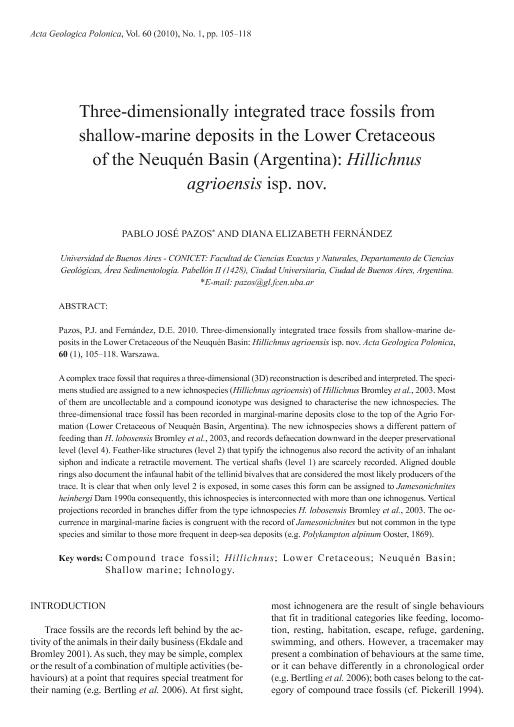Mostrar el registro sencillo del ítem
dc.contributor.author
Pazos, Pablo Jose

dc.contributor.author
Fernández, Diana Elizabeth

dc.date.available
2019-01-23T19:51:09Z
dc.date.issued
2010-03
dc.identifier.citation
Pazos, Pablo Jose; Fernández, Diana Elizabeth; Three-dimensionally integrated trace fossils from shallow-marine deposits in the Lower Cretaceous of the Neuquén Basin (Argentina): Hillichnus agrioensis isp. nov.; University of Warsaw. Institute of Geology; Acta Geologica Polonica; 60; 1; 3-2010; 105-118
dc.identifier.issn
0001-5709
dc.identifier.uri
http://hdl.handle.net/11336/68477
dc.description.abstract
A complex trace fossil that requires a three-dimensional (3D) reconstruction is described and interpreted. The specimens studied are assigned to a new ichnospecies (Hillichnus agrioensis) of Hillichnus Bromley et al., 2003. Most of them are uncollectable and a compound iconotype was designed to characterise the new ichnospecies. The three-dimensional trace fossil has been recorded in marginal-marine deposits close to the top of the Agrio Formation (Lower Cretaceous of Neuquén Basin, Argentina). The new ichnospecies shows a different pattern of feeding than H. lobosensis Bromley et al., 2003, and records defaecation downward in the deeper preservational level (level 4). Feather-like structures (level 2) that typify the ichnogenus also record the activity of an inhalant siphon and indicate a retractile movement. The vertical shafts (level 1) are scarcely recorded. Aligned double rings also document the infaunal habit of the tellinid bivalves that are considered the most likely producers of the trace. It is clear that when only level 2 is exposed, in some cases this form can be assigned to Jamesonichnites heinbergi Dam 1990a consequently, this ichnospecies is interconnected with more than one ichnogenus. Vertical projections recorded in branches differ from the type ichnospecies H. lobosensis Bromley et al., 2003. The occurrence in marginal-marine facies is congruent with the record of Jamesonichnites but not common in the type species and similar to those more frequent in deep-sea deposits (e.g. Polykampton alpinum Ooster, 1869).
dc.format
application/pdf
dc.language.iso
eng
dc.publisher
University of Warsaw. Institute of Geology
dc.rights
info:eu-repo/semantics/openAccess
dc.rights.uri
https://creativecommons.org/licenses/by-nc-sa/2.5/ar/
dc.subject
Compound Trace Fossil
dc.subject
Hillichnus
dc.subject
Lower Cretaceous
dc.subject
Neuquén Basin
dc.subject
Shallow Marine
dc.subject
Ichnology
dc.subject.classification
Meteorología y Ciencias Atmosféricas

dc.subject.classification
Ciencias de la Tierra y relacionadas con el Medio Ambiente

dc.subject.classification
CIENCIAS NATURALES Y EXACTAS

dc.title
Three-dimensionally integrated trace fossils from shallow-marine deposits in the Lower Cretaceous of the Neuquén Basin (Argentina): Hillichnus agrioensis isp. nov.
dc.type
info:eu-repo/semantics/article
dc.type
info:ar-repo/semantics/artículo
dc.type
info:eu-repo/semantics/publishedVersion
dc.date.updated
2019-01-23T17:07:02Z
dc.journal.volume
60
dc.journal.number
1
dc.journal.pagination
105-118
dc.journal.pais
Polonia

dc.journal.ciudad
Varsovia
dc.description.fil
Fil: Pazos, Pablo Jose. Consejo Nacional de Investigaciones Científicas y Técnicas. Oficina de Coordinación Administrativa Ciudad Universitaria. Instituto de Estudios Andinos "Don Pablo Groeber". Universidad de Buenos Aires. Facultad de Ciencias Exactas y Naturales. Instituto de Estudios Andinos "Don Pablo Groeber"; Argentina
dc.description.fil
Fil: Fernández, Diana Elizabeth. Consejo Nacional de Investigaciones Científicas y Técnicas. Oficina de Coordinación Administrativa Ciudad Universitaria. Instituto de Estudios Andinos "Don Pablo Groeber". Universidad de Buenos Aires. Facultad de Ciencias Exactas y Naturales. Instituto de Estudios Andinos "Don Pablo Groeber"; Argentina
dc.journal.title
Acta Geologica Polonica

dc.relation.alternativeid
info:eu-repo/semantics/altIdentifier/url/https://geojournals.pgi.gov.pl/agp/article/view/9824
Archivos asociados
